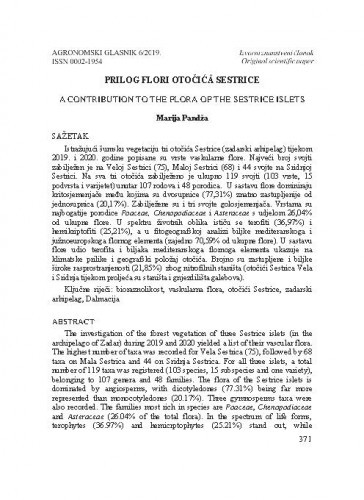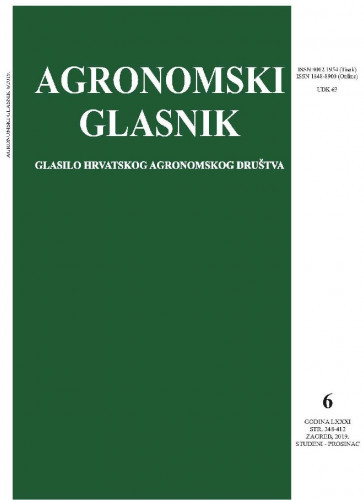Istražujući šumsku vegetaciju tri otočića Sestrice (zadarski arhipelag) tijekom 2019. i 2020. godine popisane su vrste vaskularne flore. Najveći broj svojti zabilježen je na Veloj Sestrici (75), Maloj Sestrici (68) i 44 svojte na Sridnjoj Sestrici. Na sva tri otočića zabilježeno je ukupno 119 svojti (103 vrste, 15 podvrsta i varijetet) unutar 107 rodova i 48 porodica. U sastavu flore dominiraju kritosjemenjače medu kojima su dopusnice (77,31%) znatno zastupljenije od jednosupnica (20,17%). Zabilježene su i tri svojte golosjemenjača. Vrstama su najbogatije porodice Poaceae, Chenopodiaceae i Asteraceae s udjelom 26,04% od ukupne flore. U spektru životnih oblika ističu se teretiti (36,97%) i hemikriptofiti (25,21%), a u fitogeografskoj analizi biljke mediteranskoga i južnoeuropskoga flornog elementa (zajedno 70,59% od ukupne flore). U sastavu flore udio terofita i biljaka mediteranskoga flornoga elementa ukazuje na klimatske prilike i geografski položaj otočića. Brojno su zastupljene i biljke široke rasprostranjenosti (21,85%) zbog nitrofilnih staništa (otočići Sestrica Vela i Sridnja tijekom proljeća su staništa i gnjezdilišta galebova).; The investigation of the forest vegetation of three Sestrice islets (in the archipelago of Zadar) during 2019 and 2020 yielded a list of their vascular flora. The highest number of taxa was recorded for Vela Sestrica (75), followed by 68 taxa on Mala Sestrica and 44 on Sridnja Sestrica. For all three islets, a total number of 119 taxa was registered (103 species, 15 subspecies and one variety), belonging to 107 genera and 48 families. The flora of the Sestrice islets is dominated by angiosperms, with dicotyledones (77.31%) being far more represented than monocotyledones (20.17%). Three gymnosperms taxa were also recorded. The families most rich in species are Poaceae, Chenopodiaceae and Asteraceae (26.04% of the total flora). In the spectrum of life forms, terophytes (36.97%) and hemicrptophytes (25.21%) stand out, while phytogeographic analysis showed that the plants of the Mediterranean and south European floral element prevail (together, they make more than 70.59% of the total flora). The proportion of therophytes and plants of the Mediterranean floral element in the flora indicates climate characteristics and geographic position of these islets. High proportion in their flora was also found for widely distributed plants (21.85%) because of nitrophilic habitats (during springs, the islets Sestrica Vela and Sestrica Sridnja are habitats and nest sites for seagulls).
Sažetak

 Agronomski glasnik : glasilo Hrvatskog agronomskog društva : 81,6(2019) / glavni i odgovorni urednik, editor-in-chief Ivo Miljković.
Agronomski glasnik : glasilo Hrvatskog agronomskog društva : 81,6(2019) / glavni i odgovorni urednik, editor-in-chief Ivo Miljković.